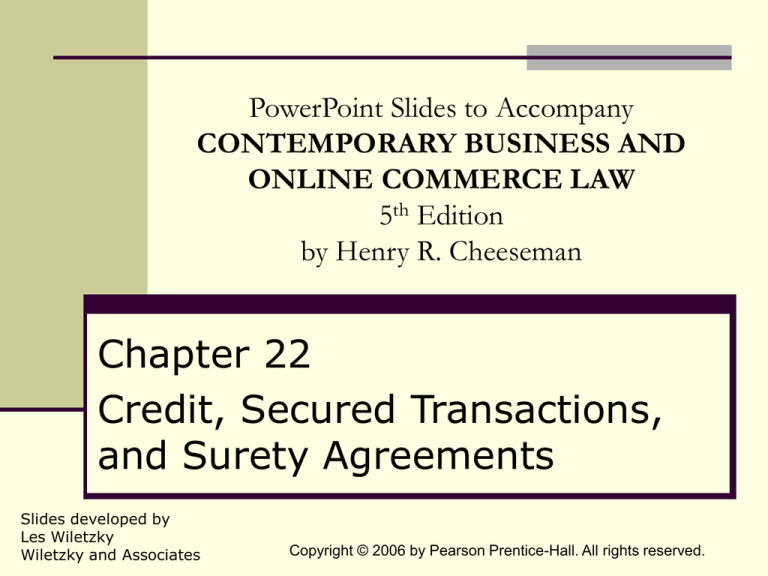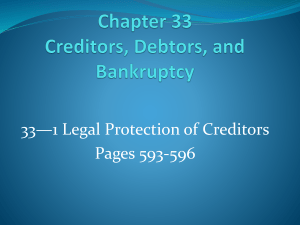
PowerPoint Slides to Accompany
CONTEMPORARY BUSINESS AND
ONLINE COMMERCE LAW
5th Edition
by Henry R. Cheeseman
Chapter 22
Credit, Secured Transactions,
and Surety Agreements
Slides developed by
Les Wiletzky
Wiletzky and Associates
Copyright © 2006 by Pearson Prentice-Hall. All rights reserved.
Introduction
The American economy is a credit
economy
Businesses and individuals use credit to
purchase many goods and services
Debtor – The borrower in a credit
transaction
Creditor – The lender in a credit
transaction
Copyright © 2006 by Pearson Prentice-Hall. All rights reserved.
22 - 2
Unsecured Credit
Credit that does not require any security
(collateral) to protect the payment of the
debt
The creditor relies on the debtor’s promise
to repay the principal (plus an interest)
when it is due
The creditor may bring legal action if the
debtor fails to make the payments
Copyright © 2006 by Pearson Prentice-Hall. All rights reserved.
22 - 3
Secured Credit
Credit that requires security (collateral)
that secures payment of the loan
Security interests may be taken in real,
personal, intangible, and other property
The collateral may be repossessed to
recover the outstanding amount if the
debtor fails to make payment
Copyright © 2006 by Pearson Prentice-Hall. All rights reserved.
22 - 4
Mortgage
A collateral arrangement where a property
owner borrows money from a creditor who
uses a deed as collateral for repayment of
the loan
Mortgagor – The owner-debtor in a
mortgage transaction
Mortgagee – The creditor in a mortgage
transaction
Copyright © 2006 by Pearson Prentice-Hall. All rights reserved.
22 - 5
Parties to a Mortgage
Loan of Funds
Owner-Debtor
Mortgagor
(Borrower)
MORTGAGE
Creditor Mortgagee
(Lender)
Security Interest in
Real Property
Copyright © 2006 by Pearson Prentice-Hall. All rights reserved.
22 - 6
Notes and Deeds of Trust
Note – An instrument that evidences the
borrower’s debt to the lender
Deed of Trust – An instrument that gives
the creditor a security interest in the
debtor’s property that is pledged as
collateral
Copyright © 2006 by Pearson Prentice-Hall. All rights reserved.
22 - 7
Parties to a Note and Deed of Trust
Loan of Funds
Creditor
Beneficiary
(Lender)
Owner-Debtor
Trustor
(Borrower)
Legal
Title
Security Interest in
Real Property
If default, can
perfect rights
Trustee
Copyright © 2006 by Pearson Prentice-Hall. All rights reserved.
22 - 8
Recording Statute
A statute that requires the mortgage or
deed of trust to be recorded in the county
recorder’s office of the county in which the
real property is located
This record gives potential lenders or
purchasers of real property the ability to
determine whether there are any existing
liens (mortgages) on the property
Copyright © 2006 by Pearson Prentice-Hall. All rights reserved.
22 - 9
Foreclosure
Legal procedure by which a secured
creditor causes the judicial sale of the
secured real estate to pay a defaulted
loan
All states permit foreclosure sales
Most states permit foreclosure by power
of sale
Copyright © 2006 by Pearson Prentice-Hall. All rights reserved.
22 - 10
Deficiency Judgment
Some states permit the mortgagee to
bring a separate legal action to recover a
deficiency from the mortgagor
If the mortgagee is successful,
the court will award a deficiency judgment
entitles the mortgagee to recover the amount
of the judgment from the mortgagor’s
property
Copyright © 2006 by Pearson Prentice-Hall. All rights reserved.
22 - 11
Right of Redemption
A right that says the mortgagor has the
right to redeem real property after default
and before foreclosure
Requires the mortgagor to pay the full
amount of the debt incurred by the
mortgagee because of the mortgagor’s
default
Copyright © 2006 by Pearson Prentice-Hall. All rights reserved.
22 - 12
Material Person’s Lien
A contractor’s and laborer’s lien that
makes the real property to which
improvements are being made become
security for the payment of the services
and materials for those improvements
Copyright © 2006 by Pearson Prentice-Hall. All rights reserved.
22 - 13
Secured Transaction
A transaction that is created when a
creditor makes a loan to a debtor in
exchange for the debtor’s pledge of
personal property as security.
Copyright © 2006 by Pearson Prentice-Hall. All rights reserved.
22 - 14
Article 9 of the UCC – Security
Interests in Personal Property
An article of the Uniform Commercial
Code (UCC) that governs secured
transactions in personal property
Article 9 has been adopted by all states
except Louisiana
Although there may be some variance
among states, most of the basics of Article
9 are the same
Copyright © 2006 by Pearson Prentice-Hall. All rights reserved.
22 - 15
Two-Party Secured Transaction
Sale of Goods on
Credit
Seller-Lender
Secured Creditor
Buyer-Debtor
Secured Interest in
the Goods
Copyright © 2006 by Pearson Prentice-Hall. All rights reserved.
22 - 16
Three-Party Secured Transaction
Buyer-Debtor
Loan of
Funds
Sale of Goods
Seller
Security
Interest in the
Goods
Lender-Secured
Creditor
Copyright © 2006 by Pearson Prentice-Hall. All rights reserved.
22 - 17
Personal Property Subject to a Security
Agreement
A security interest may be given in various
types of personal property, including:
1. goods
2. instruments
3. chattel paper
4. documents of title
5. accounts
6. general intangibles
Copyright © 2006 by Pearson Prentice-Hall. All rights reserved.
22 - 18
Creating a Security Interest in
Personal Property
Security Agreement: the agreement between the
debtor and the secured party that creates or
provides a security interest
Unless the creditor has possession of the collateral,
the security agreement must be in writing
Attachment: the creditor has an enforceable
security interest against the debtor and can satisfy
the debt out of the designated collateral
Copyright © 2006 by Pearson Prentice-Hall. All rights reserved.
22 - 19
The Floating-Lien Concept
A security interest in property that was not
in possession of the debtor when the
security agreement was executed
A floating lien can attach to:
After-acquired property
Sale proceeds
Future advances
Copyright © 2006 by Pearson Prentice-Hall. All rights reserved.
22 - 20
Perfection of a Security Interest
Establishes the right of a secured
creditor against other creditors who
claim an interest in the collateral
Perfection is a legal process
The three main methods of perfecting a
security interest under the UCC are:
1. Perfection by filing a financing statement
2. Perfection by possession of collateral
3. Perfection by a purchase monetary security interest in
consumer goods
Copyright © 2006 by Pearson Prentice-Hall. All rights reserved.
22 - 21
Summary: Methods for Perfecting
a Security Interest
Perfection Method
How Created
Financing statement
Creditor files a financing statement with the
appropriate government office.
Possession of
collateral
Creditor obtains physical possession of the collateral.
Purchase money
security interest
Creditor extends credit to a debtor to purchase
consumer goods and obtains a security interest in the
goods.
Copyright © 2006 by Pearson Prentice-Hall. All rights reserved.
22 - 22
Termination Statement
A document filed by a secured party that
ends a secured interest because the debt
has been paid
Must be filed within one month after the
debt is paid or 10 days after receipt of the
debtor’s written demand (whichever
occurs first)
Copyright © 2006 by Pearson Prentice-Hall. All rights reserved.
22 - 23
Priority of Claims
Priority – The order in which conflicting
claims of creditors in the same collateral
are solved
The priority of claims is determined
according to:
1. Whether the claim is unsecured or secured
2. The time at which secured claims were
attached or perfected
Copyright © 2006 by Pearson Prentice-Hall. All rights reserved.
22 - 24
Exceptions to the Perfection-Priority
Rule
Purchase money security interest:
inventory as collateral
Purchase money security interest: non-
inventory as collateral
Buyers in the ordinary course of business
Secondhand consumer goods
Copyright © 2006 by Pearson Prentice-Hall. All rights reserved.
22 - 25
Artisan’s and Mechanic’s Liens
If a worker in the ordinary course of
business furnishes services or materials
to someone with respect to goods and
receives a lien on the goods by statute or
rule of law, this artisan’s or mechanic’s
lien prevails over all other security
interests in the goods unless a statutory
lien provides otherwise [UCC 9-310]
Copyright © 2006 by Pearson Prentice-Hall. All rights reserved.
22 - 26
Default
Failure to make scheduled payments
when due, bankruptcy of the debtor,
breach of the warranty of ownership
as to collateral, and other events
defined by the parties to constitute
default [UCC 9-501(1)].
Copyright © 2006 by Pearson Prentice-Hall. All rights reserved.
22 - 27
UCC Remedies for Default
Upon default by the debtor, the secured party may
reduce his or her claim to judgment, foreclosure, or
otherwise enforce his or her security interest by any
available judicial procedure:
Repossession
Retention of collateral
Disposition of collateral
Proceeds from disposition
Deficiency judgment
Redemption rights
Copyright © 2006 by Pearson Prentice-Hall. All rights reserved.
22 - 28
Surety Arrangement
An arrangement where a third party
promises to be primarily liable with the
borrower for the payment of the
borrower’s debt
Surety – The third person who agrees to
be liable in a surety arrangement
Copyright © 2006 by Pearson Prentice-Hall. All rights reserved.
22 - 29
Guaranty Arrangement
An arrangement where a third party
promises to be secondarily liable for the
payment of another’s debt
Guarantor – The third person who agrees
to be liable in a guaranty arrangement
Copyright © 2006 by Pearson Prentice-Hall. All rights reserved.
22 - 30
Summary: Liability of Sureties and
Guarantors Compared
Type of
Arrangement
Party
Liability
Surety Contract
Surety
Primarily liable.
The surety is a co-debtor who is liable to pay
the debt when it is due.
Guaranty Contract Guarantor Secondarily liable.
The guarantor is liable to pay the debt if the
debtor defaults and does not pay the debt
when it is due.
Copyright © 2006 by Pearson Prentice-Hall. All rights reserved.
22 - 31
Collection Remedies (1 of 2)
When a debt is past due, the creditor may
bring a legal action against the debtor
If the creditor is successful, the court will
award a judgment against the debtor
The judgment will state that the debtor
owes the creditor a specific sum of
money:
Principal and interest past due on the debt,
Other costs resulting from the debtor’s default, and
Court costs
Copyright © 2006 by Pearson Prentice-Hall. All rights reserved.
22 - 32
Collection Remedies (2 of 2)
The most common collection remedies are:
1. Attachment
2. Execution
3. Garnishment
Copyright © 2006 by Pearson Prentice-Hall. All rights reserved.
22 - 33






